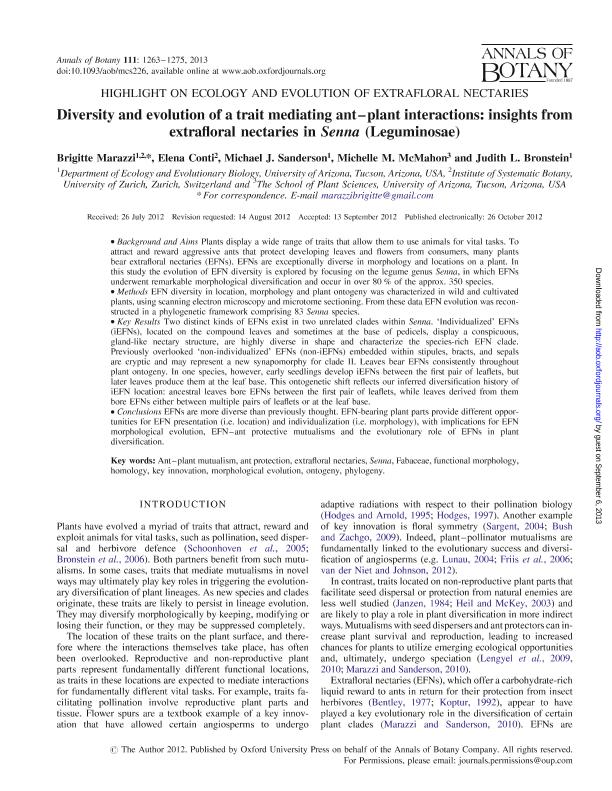Artículo
Diversity and evolution of a trait mediating ant-plant interactions : insights from extrafloral nectaries in Senna (Leguminosae)
Fecha de publicación:
06/2013
Editorial:
Oxford University Press
Revista:
Annals of Botany
ISSN:
0305-7364
e-ISSN:
1095-8290
Idioma:
Inglés
Tipo de recurso:
Artículo publicado
Clasificación temática:
Resumen
Background and Aims Plants display a wide range of traits that allow them to use animals for vital tasks. To attract and reward aggressive ants that protect developing leaves and flowers from consumers, many plants bear extrafloral nectaries (EFNs). EFNs are exceptionally diverse in morphology and locations on a plant. In this study the evolution of EFN diversity is explored by focusing on the legume genus Senna, in which EFNs underwent remarkable morphological diversification and occur in over 80 % of the approx. 350 species.
Methods EFN diversity in location, morphology and plant ontogeny was characterized in wild and cultivated plants, using scanning electron microscopy and microtome sectioning. From these data EFN evolution was reconstructed in a phylogenetic framework comprising 83 Senna species.
Key Results Two distinct kinds of EFNs exist in two unrelated clades within Senna. ‘Individualized’ EFNs (iEFNs), located on the compound leaves and sometimes at the base of pedicels, display a conspicuous, gland-like nectary structure, are highly diverse in shape and characterize the species-rich EFN clade. Previously overlooked ‘non-individualized’ EFNs (non-iEFNs) embedded within stipules, bracts, and sepals are cryptic and may represent a new synapomorphy for clade II. Leaves bear EFNs consistently throughout plant ontogeny. In one species, however, early seedlings develop iEFNs between the first pair of leaflets, but later leaves produce them at the leaf base. This ontogenetic shift reflects our inferred diversification history of iEFN location: ancestral leaves bore EFNs between the first pair of leaflets, while leaves derived from them bore EFNs either between multiple pairs of leaflets or at the leaf base.
Conclusions EFNs are more diverse than previously thought. EFN-bearing plant parts provide different opportunities for EFN presentation (i.e. location) and individualization (i.e. morphology), with implications for EFN morphological evolution, EFN –ant protective mutualisms and the evolutionary role of EFNs in plant diversification.
Archivos asociados
Licencia
Identificadores
Colecciones
Articulos(IBONE)
Articulos de INST.DE BOTANICA DEL NORDESTE (I)
Articulos de INST.DE BOTANICA DEL NORDESTE (I)
Articulos(SEDE CENTRAL)
Articulos de SEDE CENTRAL
Articulos de SEDE CENTRAL
Citación
Marazzi, Brigitte; Conti, Elena; Sanderson, Michael J.; Bronstein, Judith L.; McMahon, Michelle M.; Diversity and evolution of a trait mediating ant-plant interactions : insights from extrafloral nectaries in Senna (Leguminosae); Oxford University Press; Annals of Botany; 111; 6; 6-2013; 1263-1275
Compartir
Altmétricas




